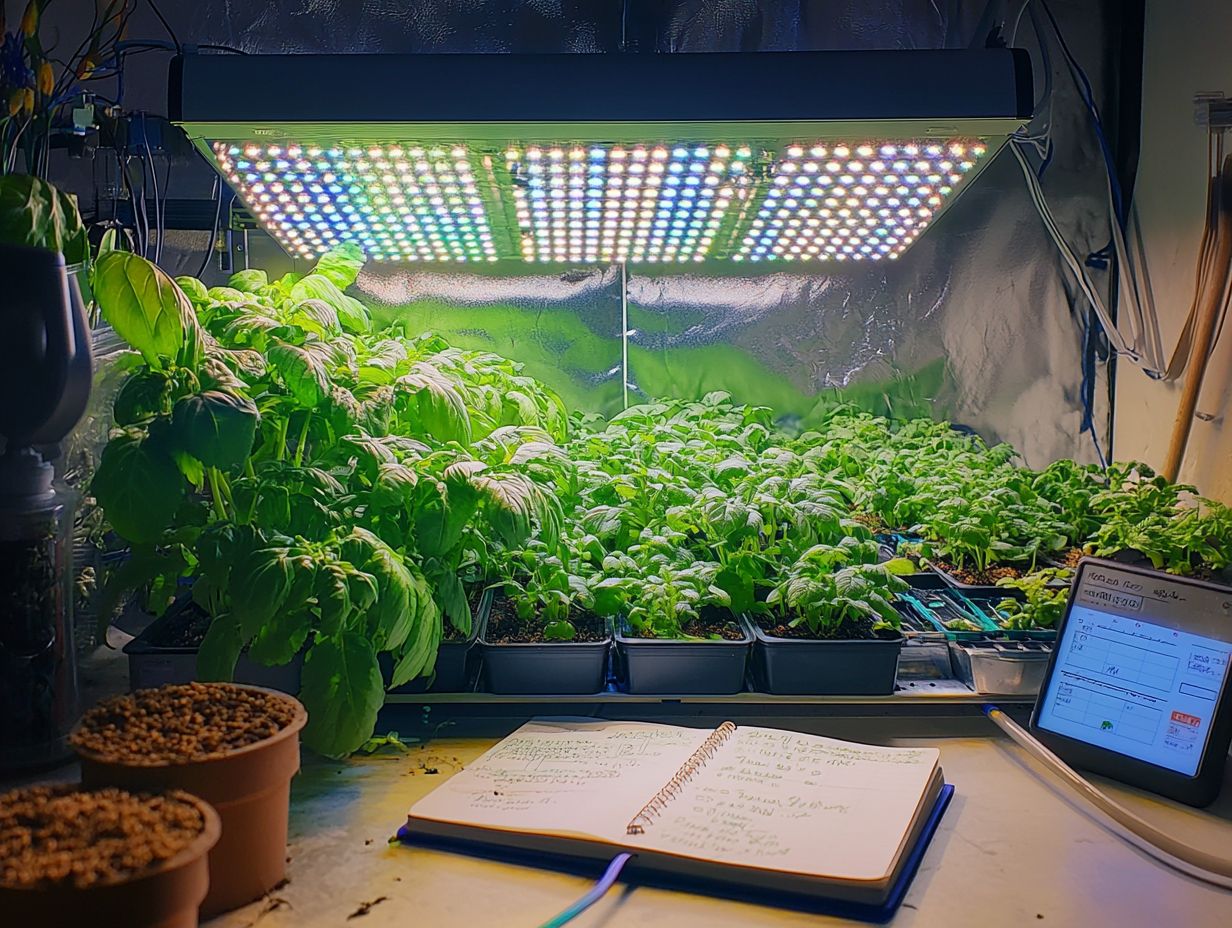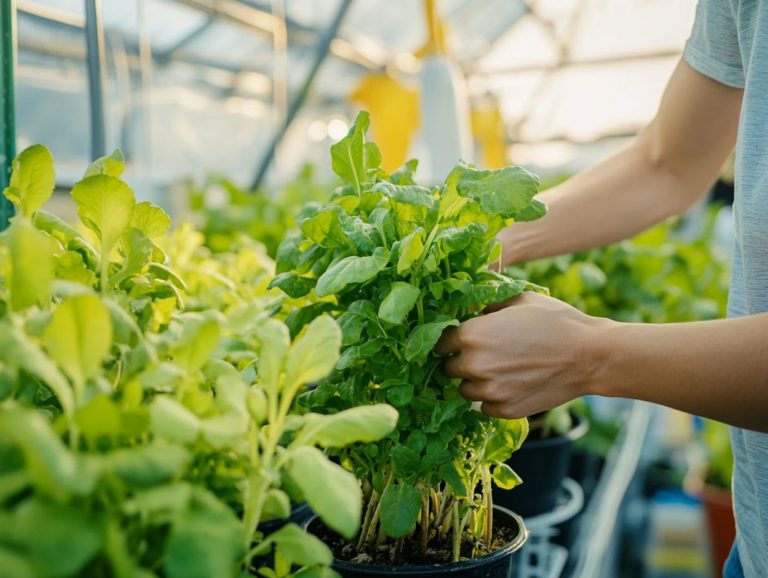Troubleshooting Hydroponic Light Schedules
Growing plants hydroponically can be a rewarding experience. However, your success hinges on mastering light management.
This article explores the essential role of light in hydroponic plant growth. You’ll learn about light intensity, duration, and how different growth stages impact light needs.
We will also address common issues like underexposure and erratic schedules. You’ll gain practical tips to troubleshoot and optimize your light schedules, ensuring vibrant plants.
Contents
- Key Takeaways:
- Importance of Light for Hydroponic Plants
- Factors to Consider in Light Scheduling
- Common Issues with Light Schedules
- Troubleshooting Light Schedule Problems
- Optimizing Light Schedules for Maximum Growth
- Frequently Asked Questions
- What is the recommended light schedule for hydroponic plants?
- My plants are not growing as expected. Could the light schedule be the issue?
- How can I determine if my light schedule is suitable for my hydroponic plants?
- What are some signs that my hydroponic plants may need a different light schedule?
- Can I change the light schedule for my hydroponic plants during different stages of growth?
- How do I adjust the light schedule for my hydroponic plants?
Key Takeaways:

- Consistency is key for hydroponic light schedules. Inconsistent exposure can lead to stunted growth.
- Adjust light schedules according to your plant’s growth stage and light intensity. Regular monitoring is crucial.
- Use troubleshooting techniques to identify light schedule problems. Regular checks for under or overexposure are essential.
Importance of Light for Hydroponic Plants
Light is vital in hydroponic gardening. It is essential for photosynthesis, which helps your plants grow and develop.
In hydroponic gardening, you will use artificial light sources like LED, HID, and fluorescent lights. These replicate natural sunlight, ensuring your plants such as tomatoes, lettuce, and spinach receive the right light intensity and colors.
By managing these elements well, you will see significant improvements in growth and yield, especially if you are a commercial grower seeking efficiency.
Factors to Consider in Light Scheduling
Several critical factors come into play when determining effective light scheduling for robust plant growth. You must consider aspects like light intensity, the color spectrum of your grow lights, and the specific wavelengths of light.
These elements are essential for establishing the optimal light cycle, particularly for indoor plants. Whether you choose LED or HID lights, understanding how these factors influence photosynthesis will empower you to maximize your yields.
Light Intensity and Duration
Light intensity and duration are crucial for the growth of your hydroponic plants. They directly impact plants’ ability to photosynthesize effectively.
Ensure your plants receive optimal light intensity whether from HID, fluorescent, or LED lights to influence their growth rates and overall health. Different plant species and their growth stages require varying light intensities.
For instance, leafy greens like lettuce and spinach thrive under lower light levels, while fruiting plants such as tomatoes need higher intensities for healthier yields.
To achieve the best results, measure light intensity using a PAR meter, which evaluates the light quality that plants can use for photosynthesis. Adjust light duration to mimic natural day/night cycles to prevent stress and enhance overall vitality.
By focusing on these factors, you create optimal growth conditions that elevate photosynthetic efficiency and foster robust plant health. Understanding the impact of light wavelengths will further enhance your success.
Plant Growth Stage
Understanding the stages of plant growth is crucial for optimizing your light schedules in hydroponic gardening. Different phases demand distinct light conditions for peak growth. For example, seedlings thrive under less intense light compared to mature plants, which flourish with higher light intensities that fuel their growth and photosynthesis.
During the germination phase, providing subdued light helps seedlings establish robust root systems without overwhelming them. As they transition into the vegetative stage, increasing both the duration and intensity of light promotes healthy foliage development, setting the stage for successful flowering.
In the flowering stage, a carefully calibrated light cycle triggers flower production while ensuring optimal nutrient uptake. By fine-tuning light exposure and adjusting intensity for each phase, you can significantly enhance the overall health and yield of your crops, ensuring that each stage receives the specific light conditions it needs to truly thrive.
Common Issues with Light Schedules

Common issues with light schedules can greatly influence your hydroponic gardening efforts. Fluctuations between underexposure and overexposure to light can severely impede plant growth.
When schedules are inconsistent, plants may experience stress, adversely affecting their ability to photosynthesize and thrive. This is particularly critical for commercial growers who rely on achieving high yields.
Under or Overexposure to Light
Underexposure or overexposure to light can significantly impact plant health in hydroponic systems, often resulting in stunted growth or, in severe cases, plant death. Recognizing the signs of these issues like leggy growth or burnt leaves is essential for cultivating an optimal environment in your hydroponic garden.
Keep a close eye on your plants for any signs of trouble! For example, if your plants are stretching toward the light source, it s a clear indication they re not getting enough light, signaling underexposure. Conversely, white or crispy edges on leaves typically indicate overexposure.
Regularly checking light intensity with a light intensity meter empowers you to make timely adjustments. If you notice signs of underexposure, act quickly by gradually increasing the light duration or intensity. If your plants show signs of overexposure, reducing their light exposure or moving them further away from the source can help mitigate any damage.
By consistently observing these parameters, you can create a balanced environment where your plants truly thrive.
Inconsistent Schedules
Inconsistent light schedules can disrupt the delicate balance that plants depend on for effective photosynthesis, ultimately impacting their growth and yield. Plants flourish under steady conditions, and any variation in light exposure can induce stress and result in uneven development.
To mitigate these risks, establishing a routine lighting schedule is crucial. Utilizing timers automates the process, ensuring that your plants receive the same amount of light each day. For more detailed insights, check out understanding electrical issues in hydroponics. This consistency not only supports photosynthesis but also fosters healthier foliage and stronger root systems.
Integrating light sensors allows for real-time adjustments based on the availability of natural light. When plants enjoy a consistent light regimen, they can absorb energy more efficiently, leading to vibrant growth and improved disease resistance.
Troubleshooting Light Schedule Problems
Troubleshooting light schedule problems is crucial for maintaining the health of your hydroponic plants and maximizing yields. By identifying issues related to light exposure, timing, and intensity, you empower yourself to make the necessary adjustments that will ensure optimal plant health.
Identifying the Issue
Identifying issues with light schedules in hydroponic systems starts with a keen observation of plant health and growth patterns. Symptoms like discoloration, stunted growth, and excessive stretching can signal problems related to light strength and duration.
As a grower, watch for signs such as leaf curl and burns. These may indicate either inadequate or excessive lighting conditions. To assess your current lighting setup effectively, utilize tools like a PAR meter, which measures light that helps plants grow. This tool helps ensure the light levels meet your plants’ specific needs at various growth stages.
By regularly monitoring and making adjustments based on measurable metrics, you can ensure optimal light exposure. For those utilizing automation in their systems, troubleshooting hydroponic system automation is key to fostering healthy growth and maximizing your yield.
Adjusting Light Schedules

Getting the light schedule right is essential for your hydroponic plants. Ensure they receive the right amount of light for effective photosynthesis and healthy growth. Minor adjustments in duration or intensity can lead to remarkable improvements in plant vitality.
For instance, if your plants thrive on more light during their growth phase, increasing the intensity can spark more vigorous growth. Conversely, if you re nurturing seedlings that are more light-sensitive, reducing the intensity can help prevent scorching and ensure they thrive.
Consistency in light cycles is vital; fluctuations can stress your plants and impede their development. Fortunately, technology offers solutions. Smart lighting systems, timers, and grow lights enable precise control over light schedules, allowing you to maintain optimal conditions without constant manual adjustments. For more detailed guidance, check out this troubleshooting guide for light issues in hydroponic gardening.
Optimizing Light Schedules for Maximum Growth
Optimizing light schedules is crucial for attaining maximum growth in hydroponic gardening. Proper management significantly impacts photosynthesis and the overall health of your plants.
Adopting best practices in light management ensures your plants receive the ideal light intensity, duration, and wavelengths needed for vigorous development.
Best Practices for Light Scheduling
Implementing best practices for light scheduling can elevate the effectiveness of your hydroponic gardening. Ensure your plants receive the optimal conditions they need for robust growth. Techniques such as using timers, understanding light colors and wavelengths, and rotating your crops help achieve balanced light exposure.
Selecting the right type of light is equally crucial. LED lights are energy-efficient and can be tailored to meet specific plant needs, while HID lights provide intense brightness, ideal for larger setups. Fluorescent lights and T5 lights are also effective for indoor gardening setups.
Incorporating light meters such as PAR meters and lux meters into your routine is a smart move. These allow you to measure intensity accurately and ensure that light levels align perfectly with your plants needs. Regularly adjusting light positions helps distribute illumination evenly across all your plants, fostering uniform growth.
By monitoring how your plants respond to changes in light conditions, including their uptake of glucose and oxygen, you can make timely adjustments. This creates an environment that promotes health and productivity.
Frequently Asked Questions
What is the recommended light schedule for hydroponic plants?
The recommended light schedule for hydroponic plants is typically 16-18 hours of artificial light per day during the vegetative stage, and 12 hours of light per day during the flowering stage.
My plants are not growing as expected. Could the light schedule be the issue?

Yes, the light schedule could be the issue. If the plants are receiving too much or too little light, it can affect their growth and development.
How can I determine if my light schedule is suitable for my hydroponic plants?
You can determine if your light schedule is suitable by monitoring the growth and health of your plants. If they are growing well, your light schedule is likely appropriate.
What are some signs that my hydroponic plants may need a different light schedule?
If your plants, including tomatoes, lettuce, or spinach, show stunted growth, yellowing leaves, or wilting, they may need a different light schedule. If they stretch toward the light source, they might not be getting enough light.
Can I change the light schedule for my hydroponic plants during different stages of growth?
Yes! It’s a good idea to adjust the light schedule during different growth stages. For instance, plants that are growing leaves need more light than those that are producing flowers.
How do I adjust the light schedule for my hydroponic plants?
To adjust the light schedule, you can manually turn the lights on and off or use a timer or ballast for automation. Make gradual changes to avoid shocking your plants.






